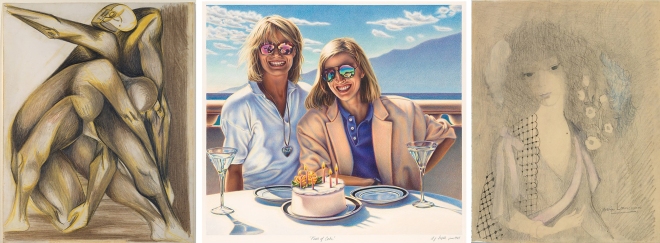What is it?
This is an easy one! We’re all very familiar with the wonderful medium of colored pencil, due to its frequent use in schools and for children’s play as well as the enjoyment of adult artists of all skill levels. Colored pencils don’t have a very clear history, but we can definitely see their development from wax-based mediums like crayons, whose use goes back as far as ancient Greece. The modern colored pencil is a narrow tool, featuring a core of pigment, wax or oil, and additives encased inside of wood. There are varying grades of quality and type, from scholastic quality to artist quality and even varieties like watercolor pencils and pastel pencils. There are two major ways of using colored pencils: layering and burnishing. Layering is a method most of us are familiar with; the pencil is used to mark the paper in layers to build up the desired color, with the finished surface letting a bit of the paper show through. Burnishing uses a colorless blending tool to smooth the layers of colored pencil, producing a shiny surface that embeds the colors deep into the grain of the paper.
Examples from art history:
For a long time, colored pencils were only used for things like grading academic papers. Slowly but surely, however, the use of pigmented pencils became seen more and more frequently in fine artwork. At first, they began to show up on combination with materials like graphite and Conte crayon in pieces that were more sketches than “finished” works. By the mid 20th century, however, their use rose in popularity and by 1990, the Colored Pencil Society of America was founded to celebrate and promote this medium, and many other countries followed with similar organizations. Here are a few examples of colored pencil works from some notable names, including Jackson Pollock (typically known for his more non-objective works and creative application of paint using a splattering or dripping method), DJ Hall (a Californian artist known for her vibrantly colored photorealistic works), and Marie Laurencin (a French painter and printmaker and one of the few female Cubists):

(left to right) Jackson Pollock, “Untitled Figure Composition” 1938-41; DJ Hall, “Piece of Cake” 1987; Marie Laurencin, “Portrait of a Young Girl” 1923
Examples from Principle Gallery:
Now, granted, colored pencil work is not something we get too often here at Principle Gallery, but we do have two very cool examples included in the current exhibition. If you haven’t gotten a chance yet to look at the images from the 10th Annual Juried Exhibition for the International Guild of Realism, visit our website here! The show is spectacular, consisting of 91 paintings and drawings from 81 different artists from around the world. Two pieces in this exhibition were created with colored pencil, and they really are incredible. If you’re in the area, please join us this Friday, August 28th, from 6:30 to 9 PM for the reception for this exhibition, as we welcome the artists and the public to enjoy these 91 amazing realist artworks!





